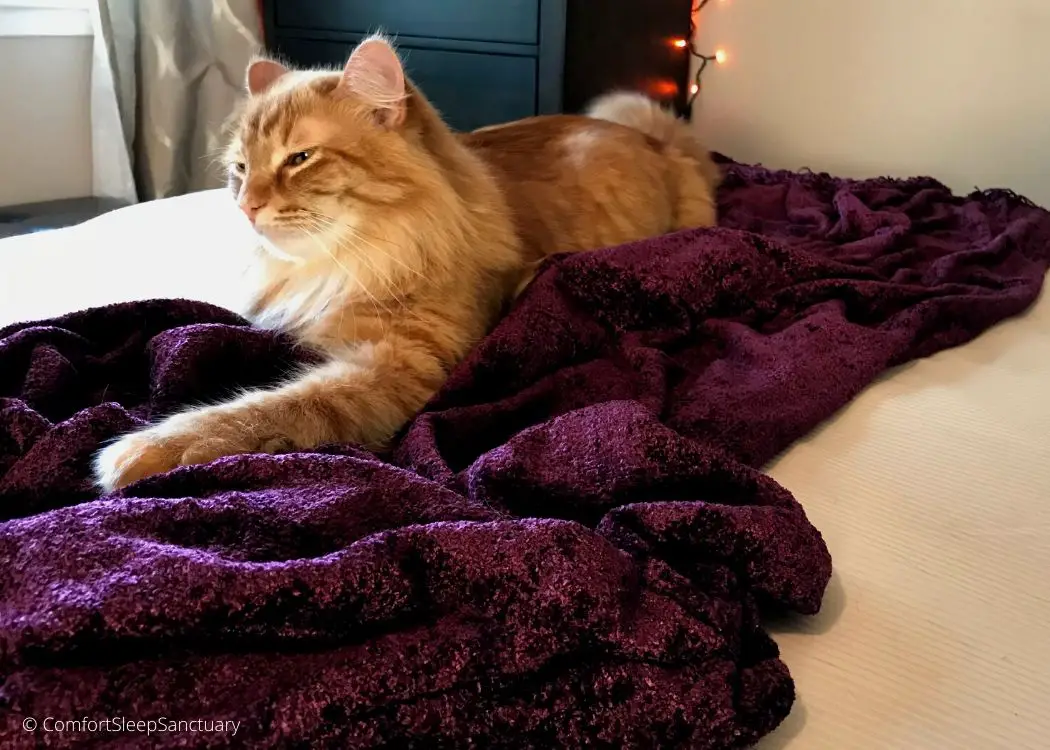Table of Contents
**This page contains affiliate links and I will be compensated if you make a purchase after clicking on my links**
You may have a throw or bedspread made of chenille. Perhaps the label tells you to DRY CLEAN ONLY.
What are your options? And what are you risking?
Yes, chenille (made of polyester) can be easily machine-washed in hot. However, without extra precautions, any fringe is at risk for turning into a giant knotted mess.
Washing in a full load may lessen (but not eliminate) the risk of the fringe knotting
What is chenille?
Chenille is the French word for caterpillar, as the yarn resembles a fuzzy furry caterpillar. Chenille fabric is soft to the touch and has an iridescent shine when viewed at different angles.
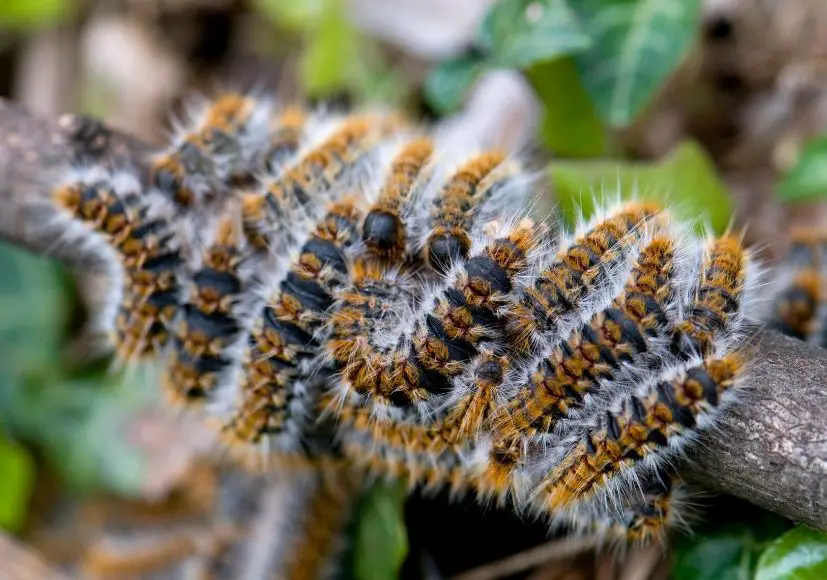
Chenille yarn is composed of a “core” of two yarns, that twist together and hold tiny lengths of yarn called “pile”. The pile may be further cut, which produces a soft feel and raised look.
In the finished cloth, the pile fibers are at an angle to other fibers and create the typical iridescent shine associated with chenille.
And yes, with wear—or the agitation of washing—the pile can separate from the core. That is why your chenille throw “sheds”. Over time, it may become thin and bare.
Manufacturers of chenille can use low-melting nylon in the core and then steam the yarn to effectively glue the pile in place.
Chenille is made from many different types of material, including cotton, polyester, viscose (rayon), acrylic, and polypropylene (olefin).
Why wash in hot?
With use, your chenille will attract body oil, bacteria, dirt, and flakes of dead skin. The latter will feed dust mites, which are microscopic critters that live in bedding. Dust mites are harmless, except for those who are allergic to their droppings.
Pets will leave fur, or other allergens they may have picked up from outside.
All told, if you have allergies or skin issues, you will need to wash your bedding and throws more often than others.
Yes, dry cleaning is a viable option, but it can get pricey over time. Dry cleaning will kill all dust mites but it won’t necessarily remove all allergens.
If you have allergies, it is recommended that you wash everything in hot water (≥ 130 ºF) with detergent. “Warm” and certainly cold water are not enough to remove everything.
Washing by hand is an option
If dry cleaning is off the table, then washing by hand is an option.
For a bedspread or throw, you’ll need a large laundry sink, bathtub, or laundry tub. Yes, you can get 130 ºF (54 ºC) water out of your tap if your hot water heater is turned up enough.
Safety tip: if you have children or invalids in the home, you should keep the hot water temperature much lower. According to the Consumer Product Safety Commission, to prevent scalding, keep your hot water set below 120 ºF.
Gently agitate the water to mix. (If the water is truly hot, limit using your hands. Consider stirring with a silicone or wooden spoon from your kitchen.)
Let your chenille soak in hot water plus detergent for at least 10-15 minutes. Then rinse well with cold water.
Press the chenille into the side of the washbasin to remove most of the water. Lightly wring it out to remove more water.
Wring dry between two towels
Heavy wringing may be more difficult for those with minimal upper-body strength. And it’s not great for the fabric.
Lay out a large clean towel on a (relatively) clean surface, such as your bathroom floor. Place the chenille on top. (Fold it so that it fits within the border of the towel.)
Place a second clean towel on top. Starting on one end, roll the towel sandwich up to create a roll.
Twist the roll to wring out excess water. One technique is to hold down one end with your foot and use both hands to twist the rest.
This should transfer the wetness of your laundry to the towels.
If your chenille is still too wet, you can repeat the process with two new dry towels.
Throw your wet towels in the dryer as usual.
If your chenille is still too wet, then throw it in the dryer as well, on low heat for a short time, such as 15 minutes. Consider placing it in a clean pillowcase to capture wayward fluff, or the pile, coming off the chenille.
Lay flat or hang to dry completely.
Your typical cotton towels will work just fine. (And I’m sure you have extras stacked up in your linen closet.)
If you want to get fancy you can use highly absorbent microfiber towels. These towels have the added benefit of fast drying. If you’re traveling—and anticipate some hand washing along the way—pack a pair of these towels.

Prepping for machine-washing
The problem with fringe
Most chenille throws and blankets have an attractive fringe of yarn at each end.
Unfortunately, this fringe is not conducive to machine-washing. It will likely become tangled and knotted.
One common recommendation on the internet is to braid the fringe first. Or macramé.
This sounds like a lot of work. (If I had this kind of time I’d be washing by hand.)
Despite all the work, there is NO guarantee the fringe won’t still tangle.
A recommendation for tassels is to straighten them, then rubber band them together.
Would this also work on the fringe of a throw? As chenille fringe is a bit delicate, before adding rubber bands I would first wrap the fringe in a thin cloth, such as a clean rag, handkerchief, bandana, or washable bamboo “paper” towel.
Alternatively, simply shop for a throw without fringe… Or one that is already braided…
Or be ready to untangle the mess…
Wash and dry within a pillowcase (or not)
If it’s a smaller piece, such as a scarf or throw, the internet recommends folding and stuffing your chenille into a pillowcase, fringe first. This may protect the chenille—and its fringe—from snagging on other items, such as zippers.
A mesh washing bag will serve the same purpose.
(It does not, however, protect the fringe from tangling on itself… In fact, I suspect the fringe may be MORE likely to tangle as it is kept close to other fringe.)
Don’t forget to tie your pillowcase closed, or your chenille will work its way out during the wash cycle.
Larger pieces, such as bedspreads, should be washed with other snag-free items, such as towels, sheets, or blankets.
Yes, dyes are more likely to run in warm and hot water. Don’t mix your bright red chenille throw with white sheets. Especially, if you’ve never tried washing it in hot water before.
Dry flat vs machine drying
Depending on what the chenille is made of, drying in a heated dryer may lead to some shrinkage. Drying on low and taking your chenille out while still damp should be okay.
To prevent snagging, keep your chenille in its “washing” pillowcase
Likewise, you can always lay it flat to dry.
Hang drying is an option, but larger pieces, such as a throw or bedspread, may stretch when hung.
Consider storing your chenille within your just-washed pillowcase. (After it’s completely dry, of course.)
Other sources of snags
Turns out washing may be the least of your dangers. Pet claws (or teeth) can easily snag and pull the yarn…

Chenille yarn may be knitted, crocheted, but it’s commonly woven. Woven fabric is most susceptible to cat claw pulls.
Don’t cut the snagged yarn. Instead, carefully stretch the fabric and allow the snagged yarn to be pulled back into the fabric.
This will reduce the length of the snag, but there usually is a little left. You can designate a top and bottom to your throw and work all the remaining snags to one side that you designate the bottom.
If the snag is especially long you can tie a knot in it, then cut the ends. Work the knot back into the fabric so that it shows less.
In the end, must pet owners have accepted that we can’t have nice things…
Wash experiment I
I purchased an inexpensive chenille throw from our favorite online store. It’s made of 100% polyester and has a generous fringe.
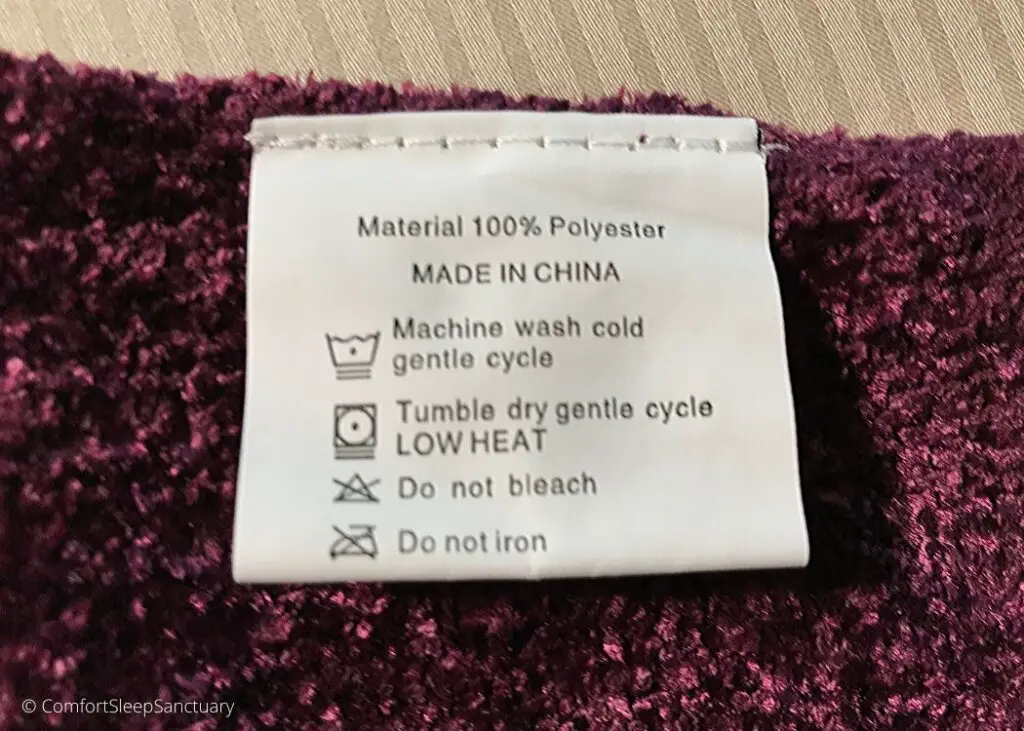
I tried braiding the fringe but gave up after the third fringe tassel…
Per the internet’s advice I placed it in a pillowcase but didn’t know I had to tie it closed.
I washed in hot, with my usual detergent, and a few other items to fill the load. (No zippers, however.)
I followed that up with a short dry cycle on low heat.
After the wash, the throw had completely worked its way out of the pillowcase.
Good news: There was no dye run from the throw; my light-colored pillowcase looked normal.
Also, there was minimal “lint” from the throw, either in the washer or dryer, no more than with the first wash of your typical cotton item. The pile held firm.
Fringe on one side of the throw was fine with no tangles.
Bad news: the fringe on the opposite side of the throw was a different story. It had completely tangled up into itself.
Question: did the pillowcase make it worse? Before placing the throw in the pillowcase, I rolled it up with the fringe all on one end.
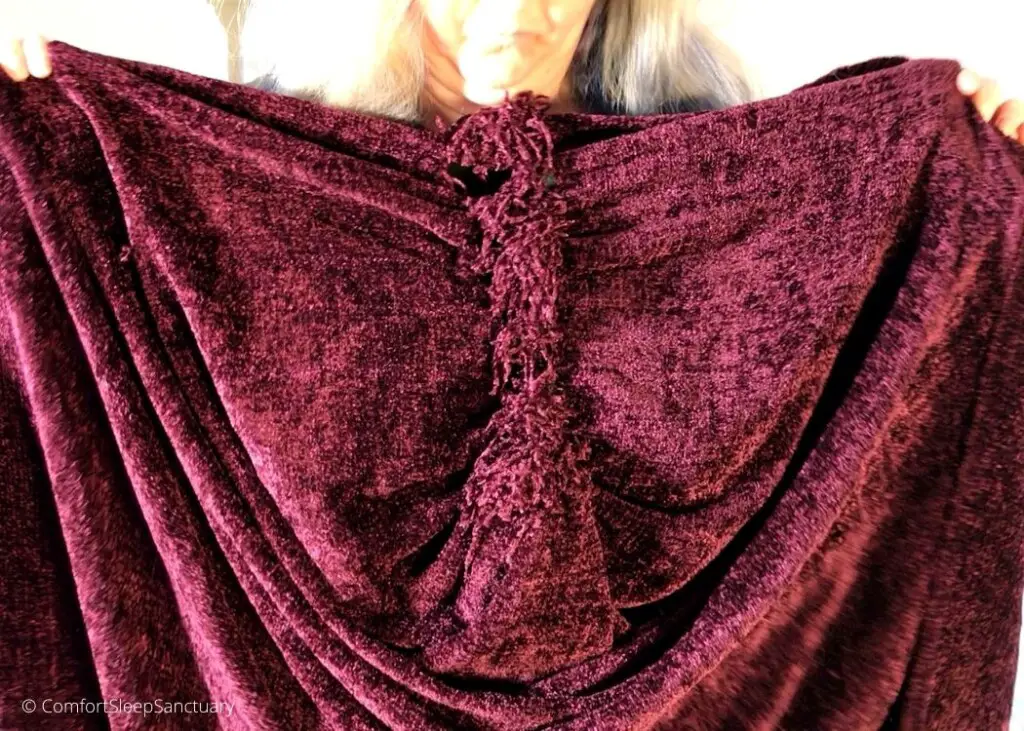
Chenille wash experiment I results
| Success! | Failure |
|---|---|
| – No color run – Minimal chenille “lint” in the washer and dryer – Fringe on one side of the throw was fine | – Fringe on the other side tangled and knotted in the wash |
Untangling the fringe
The internet has lots of suggestions, including wetting the fringe with dilute fabric softener or even hair conditioner. The problem is that wetting the fringe will tighten the knots.
My favorite suggestion: cut them off and be done with it!
The most reasonable: sit in front of the TV, enjoy the comfort of your throw, and work those knots out by hand. The key is patience.
Just as you would with your tangled hair, do not start at the base. Instead, start at the ends and work your way in. Look for a free end within the tangle and work to release it. If you get to a spot where it’s too lodged in a tangle, look for a different free end to work on.
Repeat.
If you have a knitting needle handy it may help. Otherwise your fingers work fine.
Enjoy your binge-watching. Some of the knots can be worked out by feel so you will not miss a moment of your favorite show.
Wash experiment II
In other circumstances, I would simply cut off the fringe. But as I wanted to get to the bottom of this wash problem without purchasing a second throw, I spent time untangling fringe.
Four evenings of TV binge-watching later, the fringe was finally free!
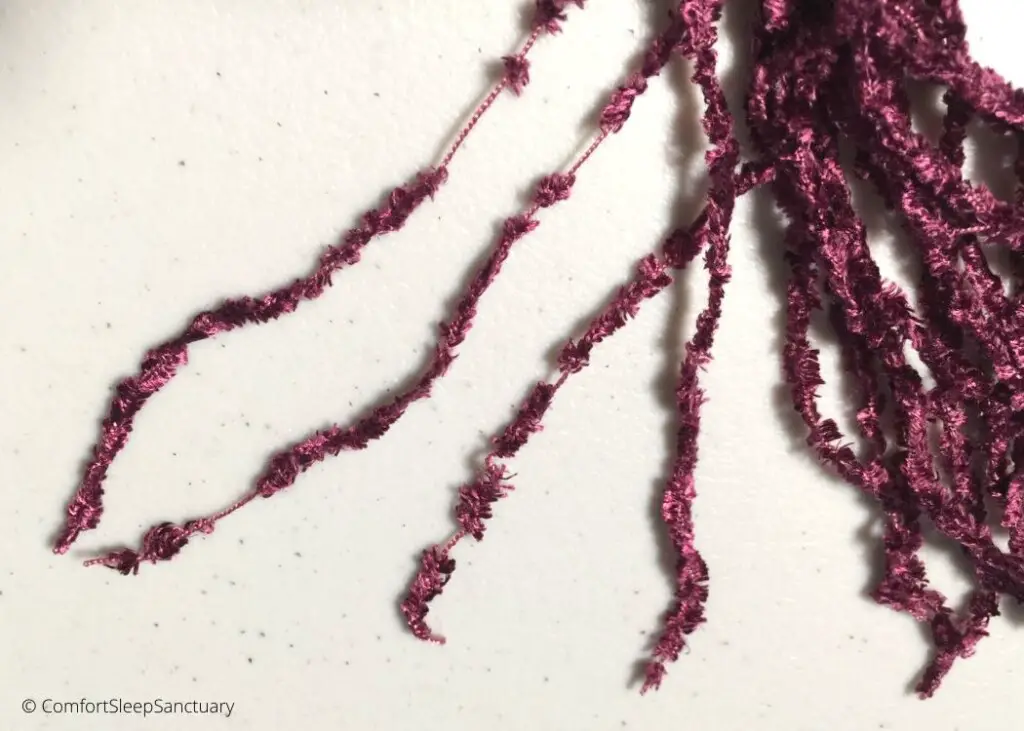
Bad news: all the yanking and pulling stripped off a lot of pile…
This is not something you will want to do more than once.
Before washing again, I wrapped one side of the fringe in sheets of reusable (washable) bamboo “paper” towel and secured each section with a rubber band.
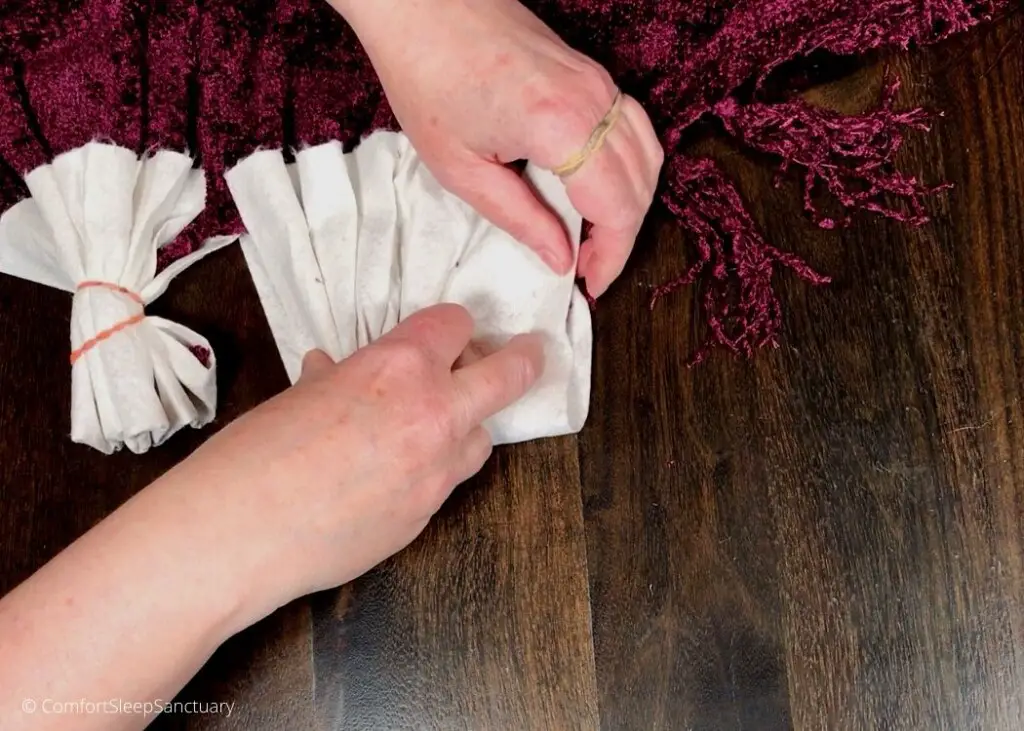
I left the fringe on the other side of the throw alone.
And washed in hot water as before. Although not a full load, I included a few towels and other things. I kept the wrapping on and dried in the dryer on low heat.
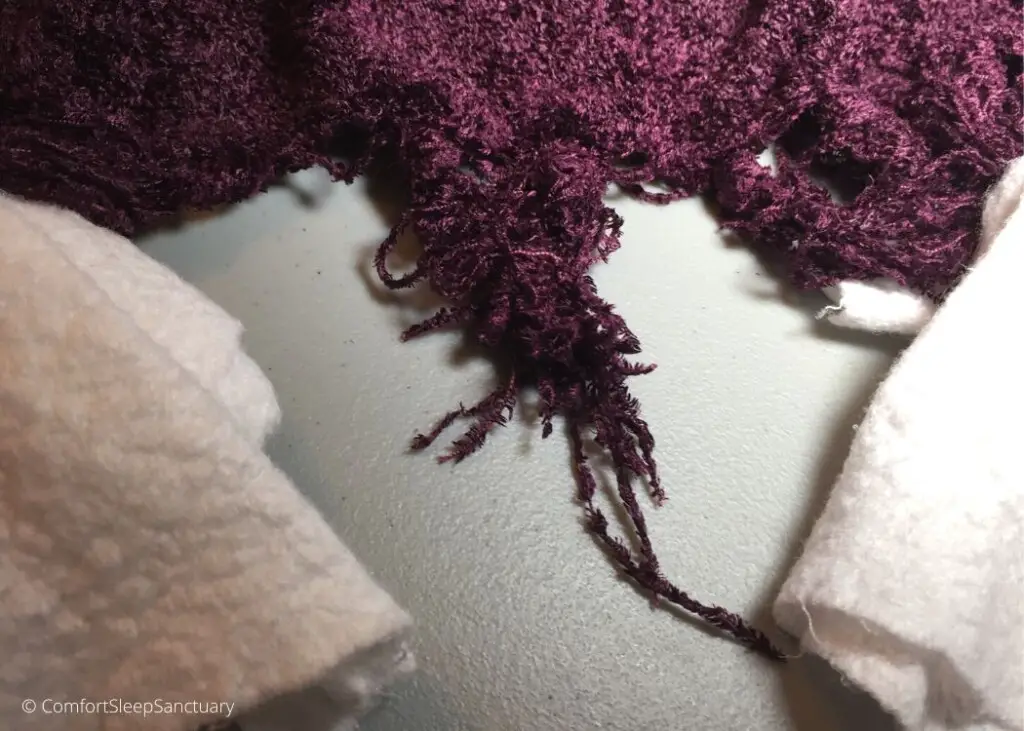
For the most part, the wrapping held. However, there were two escapees, that unfortunately, knotted together rather severely.
The rest of the wrapped fringe fared better. There was, however, some minor knotting at the tips. (Easily fixed during a single TV binge-watch session.)

What about the side of the throw that was ignored? (Other than a tiny knot at the end of a single fringe) it came out close to perfect.
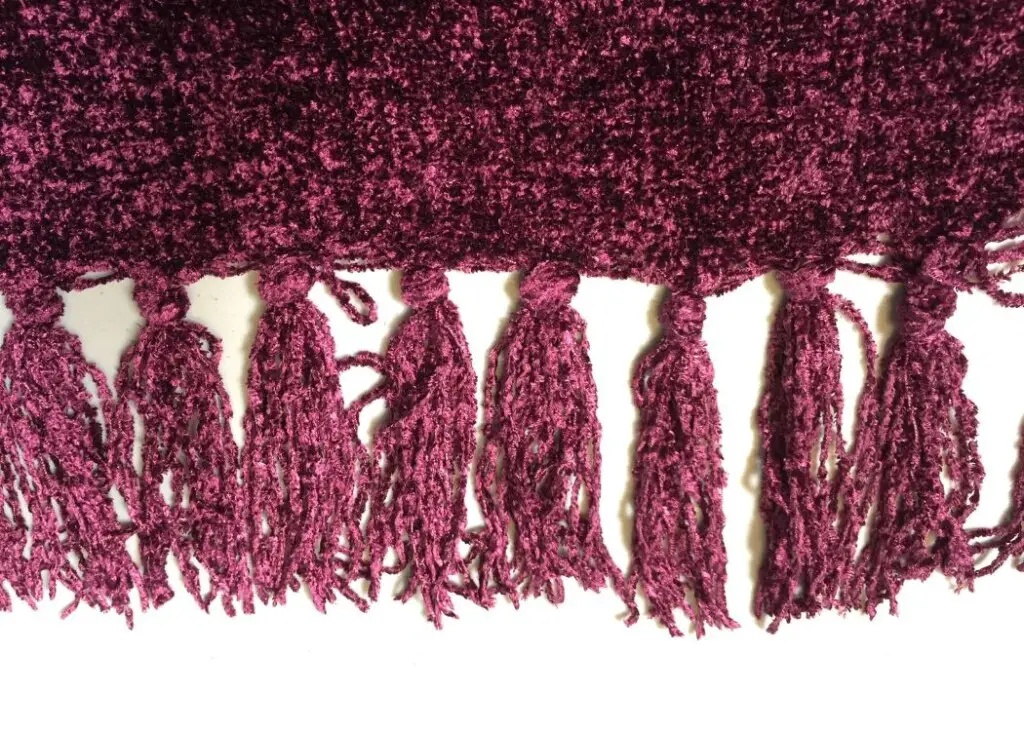
Chenille wash experiment II results
| Success! | Partial success | Failure! |
|---|---|---|
| – Side of the throw that was ignored came out fine | – Wrapped fringe knotted at the tips | – Severe knotting in fringe that escaped wrap |
What gives? This is difficult to test, but I believe keeping the fringe dispersed works best.
Wash your fringed throw in a full load. (With no snaggy items.)
Having other items in the wash may keep the fringe spread out and less likely to interact with itself and knot. Avoid pillowcases or mesh bags that will force the fringe close to other fringe.
(If I had simply tossed my throw into the laundry without another thought, it would probably have come out just fine.)
And if not, it’s time for the scissors…
In summary, yes you can machine-wash chenille made of polyester in hot water. However, the fringe is at risk. Wash in a full load to fully “disperse” the fringe.
One option is to wrap the fringe in thin cloth and secure it with rubber bands. However, this may still result in minor knotting at the tips of the fringe.
Good luck!
BONUS Video: Can You Machine-wash Chenille?
Want to learn more about the products mentioned?
[If you experience issues with menus or links not working, it is most likely due to your Ad blocker.]

